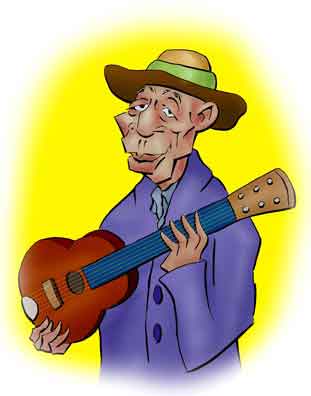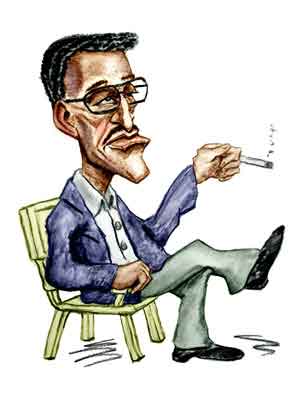Mississippi John Hurt
Unqiue

John Hurt
Mississippi John Hurt was born in Teoc, Mississippi, on March 18, 1892. His parents, Isom and Mary, had both been born slaves, and as was common for the time, they continued to work on the plantation after the Civil War. However, they worked "on shares" as it was called, turning over part of their crops to the landowner who was, of course, a former slave holder.
Mary left Teoc in 1892 and moved a few miles down the road to the town of Avalon. No one knows what happened to Isom. The marriage may simply have fallen apart due to the poverty and hard life. Or possibly Isom died in the massive yellow fever epidemic that broke out in the area.
Life was hard but there was some time for relaxation. There wasn't any television, motion pictures, or even radio. So how did people relax?
Well, the wholesome activities were picnics and church socials. But you could also just get together with your friends. Music and dances were particularly popular.
The trouble was during the late 19th and early 20th century, if you wanted music it had to be live music. You went to the music or you made it yourself. Almost every family had someone who played a musical instrument and sang.
To earn extra money, Mary took in boarders and one of them played a guitar. As John told it, when no one was around he would take the guitar and teach himself to play. John had talent, and when his mom heard how well he played, she scraped up enough money to buy John a guitar of his own. Some students of John's life think it was a Stella, and although inexpensive, was a good guitar.
John had some schooling, but began to work full time in his early teens. After he grew up, he lived on a rented farm and worked on shares. As farming was seasonal, he also did railroad work. But at night and on his time off he would play for the entertainment of himself and others, at home, at dances, or at the local general store.
John developed such a good local reputation so when a talent scout for Okeh Records came to the area, a local fiddler, William Narmouth, suggested he contact John. The scout was impressed, and in 1928, John traveled to New York where he recorded twenty songs. Not all were released - the number cited is anywhere from eight to twelve. The records actually sold fairly well, not only with the black community but also among southern whites. One family that bought a set was the Watsons from Deep Gap, North Carolina. Their son, Arthel Lane, learned John's finger picking style.
For some reason - possibly because of the Good-But-Not-Great sales - Okeh didn't follow up John's records with more releases. Of course the arrival of the Great Depression the following year had a negative effect on the recording industry. So John returned home to Avalon and continued to work as a sharecropper for the thirty-five years.
In 1958, the Kingston Trio kicked off the Folk Revival with their hit "Tom Dooley", and suddenly there were college kids who were turning their back on popular music. They grabbed guitars and banjos and those that weren't playing music from the Appalachian mountains were playing the blues. The more scholarly musicians began listening to the old 78 recordings from the 1920's and 1930's - including the Okeh records of Mississippi John Hurt.
In 1963, a young guitar player named Tom Hoskins listened to a friend play one of the old recordings of John singing "Avalon My Hometown". The sound was not typical blues but a smooth quiet style. Tom wondered if the musician was still alive, and accepting the title of the record literally and with some difficulty, he found where Avalon was. He drove down to Mississippi and pulled into the small community.
Tom asked at a local store where John Hurt lived and was directed to a small house up the road. The appearance of a unknown white man knocking at the door instilled panic in John's wife and daughter who headed out the back door. This was, we should remember, an era where segregation was still legal, the area around Greenwood had also seen considerable strife due to the Civil Rights movement. If you were black, any white person was a potential threat. But once everything was explained John agreed to play for Tom.
To make a long story short, Tom and John worked out a business arrangement, and John began to appear on college campuses, coffee houses, and folk festivals including at Newport and Philadelphia. John had write-ups in national magazines like Time and even appeared on the Tonight Show. He was featured on Pete Seeger's Rainbow Quest television show with Sonny Terry, Brownie McGhee, Paul Caldwell, and Hedy West. John's rapport with his audience was a key to his popularity and in interviews he spoke quietly with well-modulated and articulate diction.
His performance at Oberlin College on April 15, 1965 was recorded and released by mainstream recording label Vanguard as a double disc. Although The Best of John Hurt sold well, John did not realize a lot of money from his professional career, and some of his relatives say the performing and recording contracts were lopsided. John had moved to Washington, D. C., for a couple of years, a location which was more convenient for touring on college campuses and playing coffeehouses and folk clubs. But he was never really happy or comfortable away from Avalon, and after two years he returned to Mississippi.
John's music represented a unique and historically important genre of the blues and quite atypical of what we think of as acoustic blues. The delta style was developed in the pre-electric days for playing on street corners and for dances. So the guitar was played with a strong percussive style and the singing was necessarily loud and essentially shouted out.
But John's playing was the type of music that people played in their living rooms. It was a quiet finger-picking style and John's singing was likewise soft and easy going - thus saving wear and tear on his vocal chords. So when John began playing again in the 1960's his voice was largely unchanged from when he had made his recordings in 1928.
As was common for the blues, in the lyrics of John's song have quite a few double entendres. John's "Candy Man" - not to be confused with the song by Sammy Davis, Jr. - has the lyrics.
His stick of candy don't melt away
It just gets better, so the ladies say.
And sometimes John avoided controversial lyrics with a bit of sly self-censorship. As he sang in the "Richland Women's Blues"
Red rooster says,
Cock-a-doodle-do.
Rich women says
Any dude will do.
The last line brought out a guffaw from the crowd.

Sammy Davis
Not the Same Version
You can read on the Fount of All Knowledge that John first spread the "Ballad of Casey Jones". But when the famous version of the ballad was released in 1909, John was only seventeen years old. It was nearly 20 years later that John's famous series of 78 recordings were released.
Instead, John had two versions of the song telling of the legend of Casey. The most popular with the audiences was "Talking Casey. John played bottleneck to "speak" the lines and tell of the time that Casey got mad because he had to slow down his train and got behind time. Casey, John said, "commenced cussin'" and you could easily figure out the intended words from the music. That part always drew chuckles from the audience.
Sadly John lived only 3 years after he began to tour and he died on November 8, 1966. He was 72.
References
Mississippi John Hurt: His Life, His Times, His Blues, Philip Ratcliffe, University Press of Mississippi, 2011.
Mississippi John Hurt, John Hurt, Stephan GrossmanAlfred Music, 2007.
Mississippi John Hurt Foundation, http://www.mississippijohnhurtfoundation.org/.
"The curious battle over the legacy of Mississippi John Hurt", Heather Heilman, Memphis Flyer, October, 21-27, 1999.
Mississippi John Hurt: 1928 Sessions, Yazoo Records, Liner Notes, 1990.